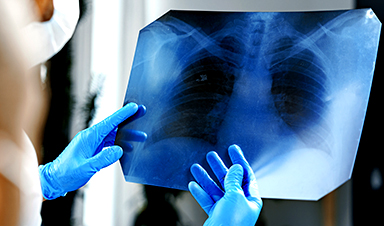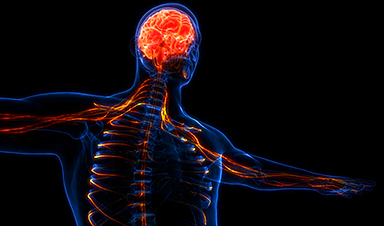Researchers discovered that during the COVID-19 pandemic, there was a surge in a rare autoimmune disease among previously unaffected demographic groups, leading to the deaths of nine patients.
COVID-19 as a Trigger for Autoimmune Response
The rise in cases is believed to be triggered by exposure to the COVID-19 virus. This condition manifests through distinctive skin rashes, pneumonia, and interstitial lung disease—a rapidly progressing type of lung inflammation that is often fatal.
"Whilst we very occasionally see this disease in the UK, this surge in cases was completely new and very different," said Principal Investigator Dennis McGonagle, Professor of Investigative Rheumatology at the University of Leeds.
"It is important that physicians understand the symptoms so that patients can be quickly referred for treatment and have the best chance of a rapid and full recovery. Lives could undoubtedly be saved but there is a great need for research to try and slow or stop the rapid lung progression that occurs in some patients," he adds.
Understanding MDA5 and Autoimmune Response
The immune system contains a protein called MDA5, which helps detect RNA viruses like COVID-19. Normally, this protein helps trigger an immune response in the body, where more of the protein is produced to help fight off the virus. However, sometimes the immune system releases antibodies that mistakenly attack this protein, leading to MDA5 autoimmune diseases such as the rare disease described in this study. The exact cause is not well understood, but scientists believe the virus itself could trigger the response. Autoimmune diseases seen after viral infections have similar features, such as fatigue, joint pain and swelling, skin rashes, and digestive issues.
Case Study and Analysis
The 60 patients in the study presented at their GPs or to A&E with a range of symptoms including shortness of breath, muscle pain, rashes, and reduced blood flow to the fingers, known as Raynaud's disease. These symptoms are associated with autoimmune disease.
The patients were referred to rheumatology specialists for further testing and all were diagnosed with the condition. Of the 60 patients, 35 had received COVID-19 vaccinations, and 15 had previously tested positive for COVID-19. However, patients were not systematically tested for COVID-19, and some may have been infected, but were asymptomatic at the time. Such cases could have developed MDA5 disease due to an overreaction of their immune system to minimal exposure to the virus.
Twenty-five out of the 60 patients (41.7%) developed interstitial lung disease, and despite treatment with immunosuppressant medication, eight of those patients died. A ninth patient, who did not have interstitial lung disease, died from sepsis.
To understand the increase in cases of this rare condition, researchers collected data on the number of these tests between January 2018 and December 2022, alongside data on COVID-19 infections and vaccination, and information about each patient's symptoms. Analysis showed that just six cases of the rare condition had been diagnosed between 2018 and 2019. However, in the 3 years after 60 new cases appeared, eight cases were diagnosed in 2020; 35 cases were diagnosed in 2021 and 17 cases were diagnosed in 2022. Very few cases have occurred since then.
Patient Demographics and Observations
Patients ranged in age from 43 to 71, with 36 of them being female.
Ethnicity:
- White: 32
- South Asian: 3
- Black Caribbean: 2
- Black African: 1
- Any other ethnic group: 4
- Asian (not Chinese): 4
- There was no ethnicity data for 14 patients.
Researchers noted that there was a strong overlap in 2021 between vaccination rates in Yorkshire and the surge in MDA5 disease cases. This peak, though, also occurred shortly after a community wave of coronavirus infection occurred in late 2021. A smaller overlap was seen between confirmed COVID-19 infection and MDA5. However, it was interesting to note that almost half (42%) of patients were not documented to have been vaccinated against COVID-19 before they tested positive for MDA5. Four children who tested positive for MDA5 were unvaccinated, pointing to the idea of an overreacting immune response after exposure to a virus.
McGonagle said: "We know that vaccines can trigger an immune overreaction, but given that not all of these patients were vaccinated against COVID-19, and the increase in cases occurred when the COVID-19 virus was circulating in significant numbers, the evidence strongly suggests that the increase in cases of this rare disease is linked to exposure to the virus."
This work was done in collaboration with Dr Pradipta Ghosh and her team at the University of California, San Diego, who showed that the MDA5 protein was found in higher amounts in patients with COVID-19 and in patients with other diseases involving MDA5. They discovered that this increase was linked to an abnormal immune response that slows the virus's ability to multiply and spread. Additionally, they found that higher levels of the MDA5 protein were associated with increased levels of Interleukin-15, a protein that activates T-cells, or immune cells. This interaction could be contributing to the autoimmune response.
Impact and Significance of Research
The study highlights the critical need for awareness among doctors about this condition to ensure prompt diagnosis and treatment, which could mitigate lung damage and save lives. This is especially so in subjects with suspected pneumonia not getting better on therapy and where the rashes, muscle involvement, and other disease features are absent.
"We think that this large, unprecedented outbreak of MDA5 disease in Yorkshire will help advance the field to better appreciate the role between viruses and autoimmunity," said Dr Paula David, the lead author of the study.
Dr. Saptarshi Sinha, the co-first author of the paper and the interim director of PreCSN, added: "Here at PreCSN, we enjoy the ability to help researchers such as the McGonagle group dive into big data and find patterns rapidly with precision that allows us to connect the dots. In this case, we are glad we could find a connection between a clinical presentation of autoimmune disease in the backdrop of COVID-19 at a molecular level."
For more on this study, see Entirely New COVID-Related Syndrome Discovered.
Reference: "MDA5-autoimmunity and interstitial pneumonitis contemporaneous with the COVID-19 pandemic (MIP-C)" by Paula David, Saptarshi Sinha, Khizer Iqbal, Gabriele De Marco, Sahar Taheri, Ella McLaren, Sheetal Maisuria, Gururaj Arumugakani, Zoe Ash, Catrin Buckley, Lauren Coles, Chamila Hettiarachchi, Emma Payne, Sinisa Savic, Gayle Smithson, Maria Slade, Rahul Shah, Helena Marzo-Ortega, Mansoor Keen, Catherine Lawson, Joanna Mclorinan, Sharmin Nizam, Hanu Reddy, Omer Sharif, Shabina Sultan, Gui Tran, Mark Wood, Samuel Wood, Pradipta Ghosh and Dennis McGonagle, 8 May 2024, eBioMedicine.
DOI: 10.1016/j.ebiom.2024.105136
The data was generated by Dr Paula David and Dr Gabriele DeMarco from the University of Leeds' School of Medicine and the Leeds Teaching Hospitals NHS Trust, with their Trust colleague Dr Khizer Iqbal.
News
New study suggests a way to rejuvenate the immune system
Stimulating the liver to produce some of the signals of the thymus can reverse age-related declines in T-cell populations and enhance response to vaccination. As people age, their immune system function declines. T cell [...]
Nerve Damage Can Disrupt Immunity Across the Entire Body
A single nerve injury can quietly reshape the immune system across the entire body. Preclinical research from McGill University suggests that nerve injuries may lead to long-lasting changes in the immune system, and these [...]
Fake Science Is Growing Faster Than Legitimate Research, New Study Warns
New research reveals organized networks linking paper mills, intermediaries, and compromised academic journals Organized scientific fraud is becoming increasingly common, ranging from fabricated research to the buying and selling of authorship and citations, according [...]
Scientists Unlock a New Way to Hear the Brain’s Hidden Language
Scientists can finally hear the brain’s quietest messages—unlocking the hidden code behind how neurons think, decide, and remember. Scientists have created a new protein that can capture the incoming chemical signals received by brain [...]
Does being infected or vaccinated first influence COVID-19 immunity?
A new study analyzing the immune response to COVID-19 in a Catalan cohort of health workers sheds light on an important question: does it matter whether a person was first infected or first vaccinated? [...]
We May Never Know if AI Is Conscious, Says Cambridge Philosopher
As claims about conscious AI grow louder, a Cambridge philosopher argues that we lack the evidence to know whether machines can truly be conscious, let alone morally significant. A philosopher at the University of [...]
AI Helped Scientists Stop a Virus With One Tiny Change
Using AI, researchers identified one tiny molecular interaction that viruses need to infect cells. Disrupting it stopped the virus before infection could begin. Washington State University scientists have uncovered a method to interfere with a key [...]
Deadly Hospital Fungus May Finally Have a Weakness
A deadly, drug-resistant hospital fungus may finally have a weakness—and scientists think they’ve found it. Researchers have identified a genetic process that could open the door to new treatments for a dangerous fungal infection [...]
Fever-Proof Bird Flu Variant Could Fuel the Next Pandemic
Bird flu viruses present a significant risk to humans because they can continue replicating at temperatures higher than a typical fever. Fever is one of the body’s main tools for slowing or stopping viral [...]
What could the future of nanoscience look like?
Society has a lot to thank for nanoscience. From improved health monitoring to reducing the size of electronics, scientists’ ability to delve deeper and better understand chemistry at the nanoscale has opened up numerous [...]
Scientists Melt Cancer’s Hidden “Power Hubs” and Stop Tumor Growth
Researchers discovered that in a rare kidney cancer, RNA builds droplet-like hubs that act as growth control centers inside tumor cells. By engineering a molecular switch to dissolve these hubs, they were able to halt cancer [...]
Platelet-inspired nanoparticles could improve treatment of inflammatory diseases
Scientists have developed platelet-inspired nanoparticles that deliver anti-inflammatory drugs directly to brain-computer interface implants, doubling their effectiveness. Scientists have found a way to improve the performance of brain-computer interface (BCI) electrodes by delivering anti-inflammatory drugs directly [...]
After 150 years, a new chapter in cancer therapy is finally beginning
For decades, researchers have been looking for ways to destroy cancer cells in a targeted manner without further weakening the body. But for many patients whose immune system is severely impaired by chemotherapy or radiation, [...]
Older chemical libraries show promise for fighting resistant strains of COVID-19 virus
SARS‑CoV‑2, the virus that causes COVID-19, continues to mutate, with some newer strains becoming less responsive to current antiviral treatments like Paxlovid. Now, University of California San Diego scientists and an international team of [...]
Lower doses of immunotherapy for skin cancer give better results, study suggests
According to a new study, lower doses of approved immunotherapy for malignant melanoma can give better results against tumors, while reducing side effects. This is reported by researchers at Karolinska Institutet in the Journal of the National [...]
Researchers highlight five pathways through which microplastics can harm the brain
Microplastics could be fueling neurodegenerative diseases like Alzheimer's and Parkinson's, with a new study highlighting five ways microplastics can trigger inflammation and damage in the brain. More than 57 million people live with dementia, [...]





















